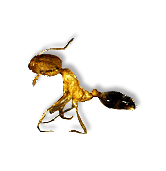General Characteristics:
- 1 to 2 mm (0.04 to 0.08 in) in length
- Bodies are reddish brown to slightly tan in colour
- Each compound eye has 20 facets and each mandible has four teeth
- Communicate through chemical markers called pheromones
- Very good eye sight and can sense vibrations of potential predators or movement from their own larvae
- Pharaoh ants feed on sweets: jelly, sugar, honey, cakes, and breads
- They also feed on greasy or fatty foods such as pies, butter, liver, and bacon
- Use chemical trails laid down by other workers in order to find food
Reproduction:
- The nest of a Pharaoh ant contains workers(sterile females), queen or queens, and male/female winged ants
- After a queen mates, she will start a new colony
- Newly mated queens may also cause the colony to “bud”. This is where part of an existing colony carries brood to another "new" nesting site along with a new queen
- After the new queen has mated with at least one male (sometimes more) she will store the sperm in her spermatheca so that she can use it to fertilize all of her eggs throughout the rest of her life
Signs of Infestation:
- Can nest in a wide variety of habitats
- In northern climates, their nests often occur within households -- the spaces in walls between the studs and insulation offer warm breeding grounds relatively hidden from humans
- difficult to gauge in population size as colonies may ‘bud’ and begin new colonies
- Can transmit various bacteria including Salmonella, Pseudomonas, Clostridium, and Staphylococcus
- Can annoy home owners by congregating on food and dishes left unattended
Control Techniques:
- Baiting programs and physical removal are only effective measures of control
- Sanitation of organic debris will reduce interior food supply and is vital for an effective baiting program
- If these ants sense chemical, as a defence mechanism, the queen may begin new colonies and the problem will worsen, therefore chemical sprays should be avoided at all times
- A professional should be contacted for control of this species as attempts by the homeowner may induce a more serious problem
Please click here to contact a Focus Pest Control professional to inquire about further treatments for this pest species.
References:
Benett, Gary W., et.al.. Truman’s Scientific Guide to Pest Control Operations. Duluth: Advanstar Communications, 1988. Pp. 187-188.
Morris, D. 2000. "Monomorium pharaonis" (On-line), Animal Diversity Web. Accessed August 24, 2009 at http://animaldiversity.ummz.umich.edu/site/accounts/information/Monomorium_pharaonis.html.
Disclaimer:
The Focus Pest Control ‘Pest Library’ is an educational resource written largely to educate the general public about common pests in Ontario. The Focus ‘Pest Library’ does not include all species in Ontario, nor does it include the most recent scientific data about species we describe. Though we edit our accounts for accuracy, we cannot guarantee all information in those accounts. While Focus Pest Control staff and contributors provide references to books and websites that we believe are reputable, we cannot necessarily endorse the contents of references beyond our control.
(Back to top)
|


